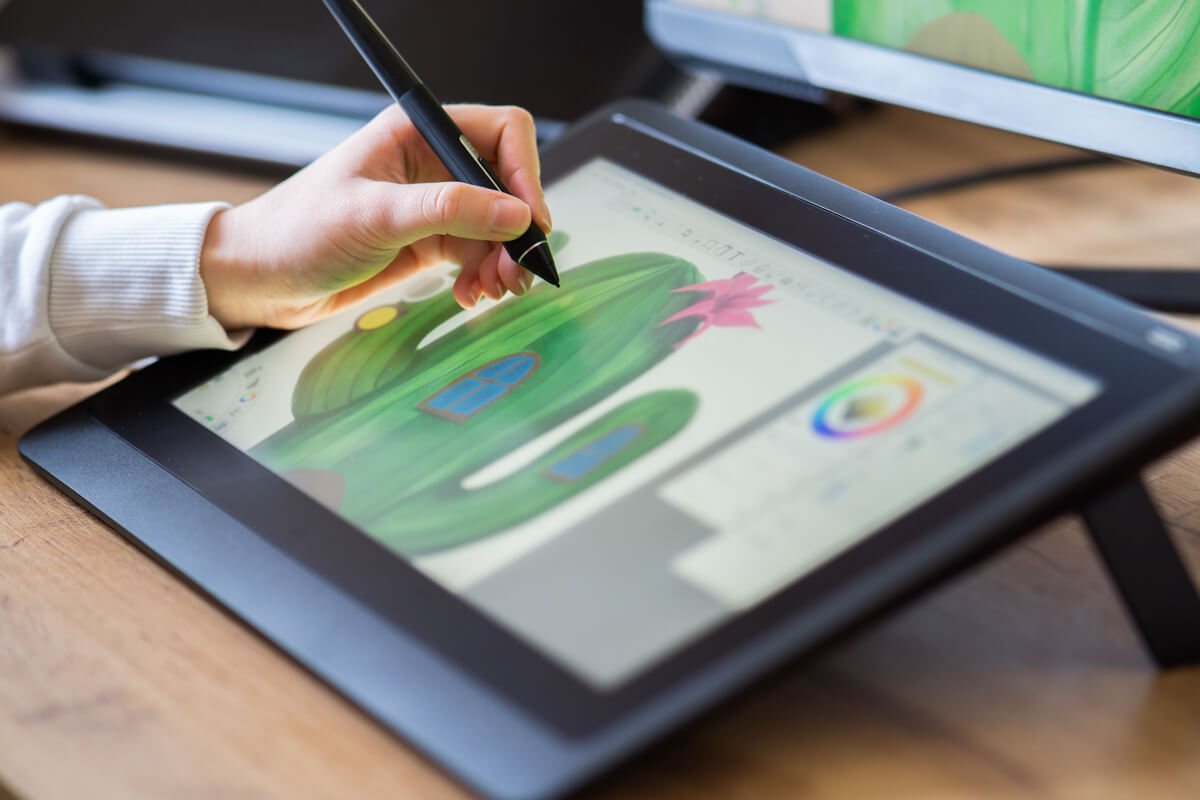It’s difficult to predict exactly what web design trends will dominate in 2023 as technology and user preferences constantly evolve. However, here are some potential trends that may emerge in the next few years:
Dark mode: Dark mode is a color scheme that uses dark colors instead of light colors for the background and text of a website. Dark mode can be more accessible to the eyes, especially in low-light environments, and can also help to reduce power consumption on devices with OLED displays. To implement dark mode on a website, designers can use CSS media queries to detect the user’s system preference for dark mode and apply a dark color scheme accordingly.
3D design elements: 3D design elements are three-dimensional objects or graphics that can create a more immersive and interactive user experience on a website. 3D design elements can be created using software like Blender or Cinema 4D and incorporated into a website using technologies like WebGL.
Personalization: Personalization involves tailoring the user experience to individual preferences. This can be achieved through the use of artificial intelligence and machine learning to analyze user behavior and tailor the content and features of a website accordingly. Personalization can be implemented through content recommendation engines, product recommendations, and email marketing.
Microinteractions: Microinteractions are small, interactive elements that provide feedback to the user and enhance the overall user experience. Examples of microinteractions include hover effects, loading indicators, and notification alerts. Microinteractions can be implemented using JavaScript or CSS and can make a website more engaging and interactive.
Responsive design: Responsive design is a design approach that allows a website to adapt to different screen sizes and devices. This ensures a consistent user experience across all devices and can improve the usability of a website on mobile devices. Responsive design can be achieved using CSS media queries and flexible grid layouts.
Voice user interface (VUI): Voice user interface (VUI) design involves creating awebsite that can be navigated and interacted with using voice commands. This can be achieved through the use of voice recognition software and natural language processing algorithms. VUI design can be particularly useful for users with disabilities or for users who prefer to use voice commands instead of a mouse and keyboard.
Motion design: Motion design involves the use of animation and movement to enhance the user experience. This can be achieved through techniques like parallax scrolling, hover effects, and scroll-triggered animation. Motion design can be implemented using technologies like CSS3 and JavaScript and can make a website more engaging and interactive.
Accessibility: Accessibility refers to the practice of designing websites that are accessible to users with disabilities. This can involve techniques like using high-contrast color schemes, providing alt text for images, and using clear and concise headings and labels. Accessibility is important because it ensures that all users, including those with disabilities, can access and use a website.
Minimalism: Minimalist design involves using simple and minimal elements to create a clean and uncluttered user interface. This can be achieved through techniques like using whitespace, limiting the use of graphics and images, and using simple and minimal color schemes. Minimalist design can make a website easier to navigate and can help to focus the user’s attention on the most important content.
E-commerce functionality: E-commerce functionality refers to the ability of a website to facilitate online transactions and the sale of products or services. This can include features like online payment options, shopping carts, and product galleries. E-commerce functionality is important for businesses that want to sell products or services online and can be implemented using tools like WooCommerce or Shopify.
Virtual reality (VR) and augmented reality (AR) integration: Virtual reality (VR) and augmented reality (AR) are technologies that allow users to experience immersive and interactive environments. It’s possible that more websites will incorporate VR and AR elements in the coming years to create a more immersive and interactive user experience. VR and AR can be implemented using technologies like WebVR and AR.js.
Chatbots and AI-powered customer service: Chatbots are computer programs that can simulate conversation with human users. Theycan be used to provide customer service and answer common questions, freeing up human customer service representatives to handle more complex issues. AI-powered customer service can also involve the use of natural language processing algorithms to analyze customer inquiries and provide personalized responses.
Interactive and immersive storytelling: Interactive and immersive storytelling involves using multimedia elements like video, animation, and interactive elements to tell a story or convey information. This can create a more engaging and interactive user experience and can be implemented using technologies like HTML5 and JavaScript.
Video backgrounds and cinemagraphs: Video backgrounds and cinemagraphs are short, looping video or GIFs that can be used as the background of a website. They can add movement and interest to a website and can be implemented using technologies like HTML5 and CSS.
Serif fonts: Serif fonts are typefaces that have small decorative flourishes or strokes at the end of the letterforms. Serif fonts can add a sense of sophistication and elegance to a website and are likely to continue to be a popular trend in web design.
Gradients and color transitions: Gradients and color transitions involve the use of smooth color transitions to create a more dynamic and visually appealing user interface. Gradients and color transitions can be implemented using CSS and can add interest and depth to a website.
Asymmetrical layouts: Asymmetrical layouts involve the use of uneven or irregular grid layouts to create a more visually interesting and dynamic user interface. Asymmetrical layouts can be implemented using CSS grid and flexbox and can add a sense of creativity and uniqueness to a website.
Hand-drawn and organic design elements: Hand-drawn and organic design elements involve the use of elements that have a more organic or handmade feel, such as hand-drawn illustrations or organic shapes. These elements can add a sense of personality and uniqueness to a website and can be implemented using vector graphics software like Adobe Illustrator.
Scroll-triggered animation: Scroll-triggered animation involves using JavaScript to trigger animations as the user scrolls down the page. This can add a sense of dynamism and interactivity to a website and can be a powerful way to engage the user’s attention.
Niche-specific design trends: Finally, it’s likely that certain niche-specific design trends will emerge in the coming years. For example, gaming websites may incorporate more 3D design elements and motion design, while medical websites may focus more on accessibility and user friendliness. By staying up-to-date with the latest trends and best practices in their specific industry, businesses and individuals can create websites that are well-suited to their target audience and meet the needs of their users.
These are just a few potential web design trends that may emerge in 2023. New trends and best practices will likely emerge as technology and user preferences evolve. It will be necessary for designers to stay up-to-date and adapt their approaches accordingly. Designers need to stay up-to-date with the latest trends and best practices and carefully consider their projects’ needs and goals when choosing design elements and strategies. By following these guidelines, Tomorrow Web Design Company can create effective, engaging, and user-friendly websites.
Table of Contents
Share on
It’s difficult to predict exactly what web design trends will dominate in 2023 as technology and user preferences constantly evolve. However, here are some potential trends that may emerge in the next few years:
Dark mode: Dark mode is a color scheme that uses dark colors instead of light colors for the background and text of a website. Dark mode can be more accessible to the eyes, especially in low-light environments, and can also help to reduce power consumption on devices with OLED displays. To implement dark mode on a website, designers can use CSS media queries to detect the user’s system preference for dark mode and apply a dark color scheme accordingly.
3D design elements: 3D design elements are three-dimensional objects or graphics that can create a more immersive and interactive user experience on a website. 3D design elements can be created using software like Blender or Cinema 4D and incorporated into a website using technologies like WebGL.
Personalization: Personalization involves tailoring the user experience to individual preferences. This can be achieved through the use of artificial intelligence and machine learning to analyze user behavior and tailor the content and features of a website accordingly. Personalization can be implemented through content recommendation engines, product recommendations, and email marketing.
Microinteractions: Microinteractions are small, interactive elements that provide feedback to the user and enhance the overall user experience. Examples of microinteractions include hover effects, loading indicators, and notification alerts. Microinteractions can be implemented using JavaScript or CSS and can make a website more engaging and interactive.
Responsive design: Responsive design is a design approach that allows a website to adapt to different screen sizes and devices. This ensures a consistent user experience across all devices and can improve the usability of a website on mobile devices. Responsive design can be achieved using CSS media queries and flexible grid layouts.
Voice user interface (VUI): Voice user interface (VUI) design involves creating awebsite that can be navigated and interacted with using voice commands. This can be achieved through the use of voice recognition software and natural language processing algorithms. VUI design can be particularly useful for users with disabilities or for users who prefer to use voice commands instead of a mouse and keyboard.
Motion design: Motion design involves the use of animation and movement to enhance the user experience. This can be achieved through techniques like parallax scrolling, hover effects, and scroll-triggered animation. Motion design can be implemented using technologies like CSS3 and JavaScript and can make a website more engaging and interactive.
Accessibility: Accessibility refers to the practice of designing websites that are accessible to users with disabilities. This can involve techniques like using high-contrast color schemes, providing alt text for images, and using clear and concise headings and labels. Accessibility is important because it ensures that all users, including those with disabilities, can access and use a website.
Minimalism: Minimalist design involves using simple and minimal elements to create a clean and uncluttered user interface. This can be achieved through techniques like using whitespace, limiting the use of graphics and images, and using simple and minimal color schemes. Minimalist design can make a website easier to navigate and can help to focus the user’s attention on the most important content.
E-commerce functionality: E-commerce functionality refers to the ability of a website to facilitate online transactions and the sale of products or services. This can include features like online payment options, shopping carts, and product galleries. E-commerce functionality is important for businesses that want to sell products or services online and can be implemented using tools like WooCommerce or Shopify.
Virtual reality (VR) and augmented reality (AR) integration: Virtual reality (VR) and augmented reality (AR) are technologies that allow users to experience immersive and interactive environments. It’s possible that more websites will incorporate VR and AR elements in the coming years to create a more immersive and interactive user experience. VR and AR can be implemented using technologies like WebVR and AR.js.
Chatbots and AI-powered customer service: Chatbots are computer programs that can simulate conversation with human users. Theycan be used to provide customer service and answer common questions, freeing up human customer service representatives to handle more complex issues. AI-powered customer service can also involve the use of natural language processing algorithms to analyze customer inquiries and provide personalized responses.
Interactive and immersive storytelling: Interactive and immersive storytelling involves using multimedia elements like video, animation, and interactive elements to tell a story or convey information. This can create a more engaging and interactive user experience and can be implemented using technologies like HTML5 and JavaScript.
Video backgrounds and cinemagraphs: Video backgrounds and cinemagraphs are short, looping video or GIFs that can be used as the background of a website. They can add movement and interest to a website and can be implemented using technologies like HTML5 and CSS.
Serif fonts: Serif fonts are typefaces that have small decorative flourishes or strokes at the end of the letterforms. Serif fonts can add a sense of sophistication and elegance to a website and are likely to continue to be a popular trend in web design.
Gradients and color transitions: Gradients and color transitions involve the use of smooth color transitions to create a more dynamic and visually appealing user interface. Gradients and color transitions can be implemented using CSS and can add interest and depth to a website.
Asymmetrical layouts: Asymmetrical layouts involve the use of uneven or irregular grid layouts to create a more visually interesting and dynamic user interface. Asymmetrical layouts can be implemented using CSS grid and flexbox and can add a sense of creativity and uniqueness to a website.
Hand-drawn and organic design elements: Hand-drawn and organic design elements involve the use of elements that have a more organic or handmade feel, such as hand-drawn illustrations or organic shapes. These elements can add a sense of personality and uniqueness to a website and can be implemented using vector graphics software like Adobe Illustrator.
Scroll-triggered animation: Scroll-triggered animation involves using JavaScript to trigger animations as the user scrolls down the page. This can add a sense of dynamism and interactivity to a website and can be a powerful way to engage the user’s attention.
Niche-specific design trends: Finally, it’s likely that certain niche-specific design trends will emerge in the coming years. For example, gaming websites may incorporate more 3D design elements and motion design, while medical websites may focus more on accessibility and user friendliness. By staying up-to-date with the latest trends and best practices in their specific industry, businesses and individuals can create websites that are well-suited to their target audience and meet the needs of their users.
These are just a few potential web design trends that may emerge in 2023. New trends and best practices will likely emerge as technology and user preferences evolve. It will be necessary for designers to stay up-to-date and adapt their approaches accordingly. Designers need to stay up-to-date with the latest trends and best practices and carefully consider their projects’ needs and goals when choosing design elements and strategies. By following these guidelines, Tomorrow Web Design Company can create effective, engaging, and user-friendly websites.





